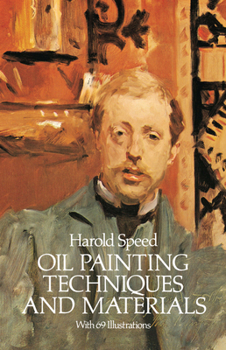Oil Painting Techniques and Materials
Select Format
Select Condition 
Book Overview
"In any exhibition of amateur work . . . it is not at all unusual to find many charming water-colour drawings, but . . . it is very rarely that the work in the oil medium is anything but dull, dead, and lacking in all vitality and charm." -- Harold Speed
Such provocative assertions are characteristic of this stimulating and informative guide, written in a highly personal and unique style by a noted painter and teacher. Brimming with pertinent...
Format:Paperback
Language:English
ISBN:0486255069
ISBN13:9780486255064
Release Date:December 1987
Publisher:Dover Publications
Length:368 Pages
Weight:0.89 lbs.
Dimensions:0.7" x 5.4" x 8.4"
Customer Reviews
4 ratings
A Must Read Book for the Serious Artist
Published by Thriftbooks.com User , 17 years ago
As a professional artist I have been a long time admirer of Harold Speed's books. If you are interested in learning the craft of painting the human figure in oil, then there is really no better primer than Oil Painting Techniques by Harold Speed. From my own experience in painting I have come to find that Speed's approach is the most intelligent and manageable of any I've studied. It's a method that applies to any subject, not just figure painting. No cheap gimmicks or "tricks," just good common sense and a clear explanation how to break down the spectrum of visual data into the most important components.
Beyond A "How To Book"
Published by Thriftbooks.com User , 18 years ago
Harold Speed does a great job explaining the philosophy, method and techniques of sound traditional oil painting. If you are looking for a simple "how to" book, this is not for you. It goes much deeper than that, with various masters' works analyszed for their methods. This book describes many of the nuances of traditional oil painting that are so sadly lacking in many of today's popular painters. The stress is on the craftsmanship that has been all but abandoned.
One of the best books on painting
Published by Thriftbooks.com User , 19 years ago
The Speed's book was originally published in 1924. There is another excellent and modern book basically covering same topics: "Alla Prima, Everything I Know about Painting" by Schmid. In comparison, Speed's book is physically much smaller, (less than 2/3 of Schmid's), but it is distilled and very rich. It gives a concise yet in-depth discussion of the most fundamental things about painting: wholeness, unity & variety, and rhythm etc., under topics of tone value, color, edge, and design, while form and drawing are mainly discussed in his another book. While the Schmid's book is easier to understand for beginner, the two books target the same levels of readers. When reading Speed's book, it's better to read carefully between the words. You can read Schmid's book faster, because Schmid's book uses more sentences or paragraphs to explain an idea. For example, on make decision about which edges you should paint or to blur, Schmid gives you several paragraphs of useful advice, while Speed has one-sentence summarization: "It is not the edges of the object but the edges of the tone masses that make up the visual impression, that you are painting". The sentence may be easily neglected and skipped by someone with first time reading, but if he carefully reads the context and understands the meaning, it becomes useful not only in edges selection, but also in picture design. The book's analysis of paintings by old masters is practical and insightful. One example is its comment on an early portrait (plate 32) by Velasquez, that the edge going from the wing of the nostril to the outside of the mouth weaken the wholeness of the pictorial design. By this way, it helps you understand deeper not only the concept of wholeness and the function of edges, but also good design. The book's most significant concentration is on the mental part of the painting process, mainly about what & how to see and to design, rather than on learning particular painting techniques and materials, therefore, I believe that the author's original title "The Science & Practice of Oil Painting" is a better one in telling you what is in the book. The book used one chapter, 10% of the whole book, discussing `modern art', which I think is a bit too much. (Both Speed and Schmid basically hold same opinion on `modern art'. Schmid has the mentioning that what we called `Modern Art' is a different human activity from `Classical Art' except that `Modern' artists use, some times, the same tools as `Classical' artists.) I highly recommend this book to everyone. For beginner, if you do not read carefully, you will only read the surface, so that you think the book is statically for beginner. But when you grow and you carefully read it again, you will find it is rich and it grows with you. For the very advanced, you can review its points for successful painting, which is concisely presented in the book.
Exceptional
Published by Thriftbooks.com User , 22 years ago
This book, originally published in 1924, is one of the best books I have ever read on the subject. The author's insight into not only technique, but the artist's mindset is truely a treasure. This book is a must read for any serious painter, as well for any serious artist.






